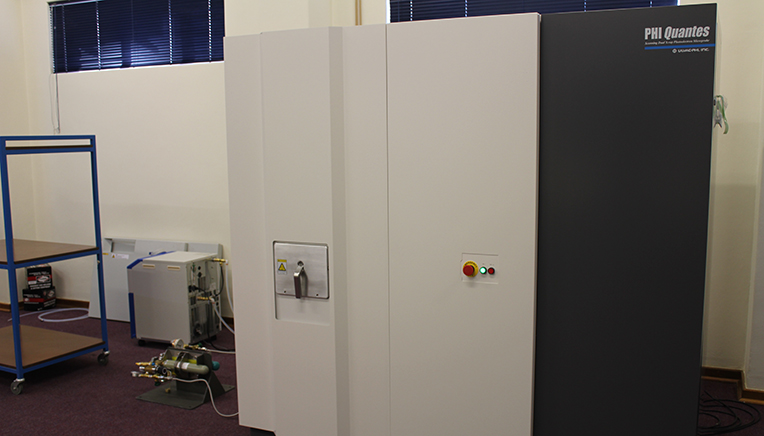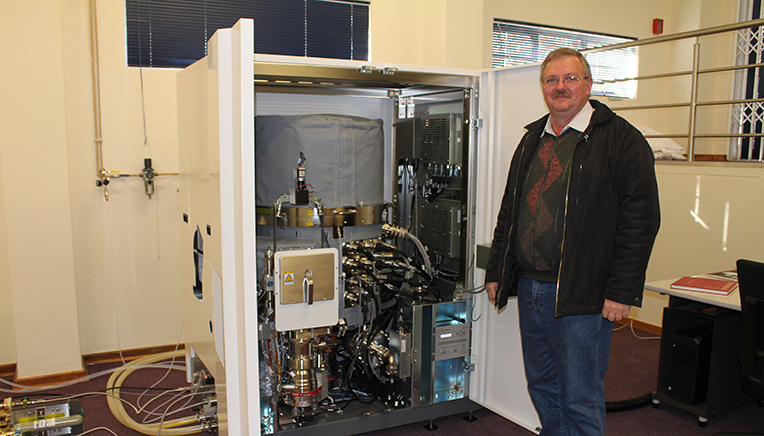The state-of-the-art equipment in the
Department of Physics at the
University of the Free State (UFS) differentiates this department from its competitors. Availability of the equipment makes it possible for researchers as well as students to deliver work that receives national and international recognition.
Recently, the department acquired a PHI Quantes XPS system, the first in Africa and one of only 20 in the world.
Creating better phosphor
“The Quantes XPS system uses X-rays to determine the chemical composition of molecules on the surface of a sample. The system is unique in the sense that it also has an extra X-ray source that can determine the chemical state below the surface,
which was not possible in the past. This will help us to dictate the position of defects in our phosphor materials that will consequently enable us to create better phosphor for solid state lighting as well as solar cell applications,”
explains
Prof Hendrik Swart,
Senior Professor in the Department of Physics, who also holds the
SARChI Chair in Solid State Luminescent and Advanced Materials.
After he had the opportunity to observe the system in the factory in Chigasaki, Kanagawa, Japan, where he attended a conference, Prof Swart was very impressed by its performance. He discussed it with
Prof Koos Terblans, Head of the department, and other colleagues, and started making plans to buy the system.
When the department first bought the X-ray photoelectron spectroscopy (XPS) system in 2007/2008, it became the national facility on XPS measurements. Not only is this an upgrade of the XPS system bought 14 years ago, but the new system will enable the
department to do more measurements. “The number of samples that we have to handle has just become too much for one system. The new system’s increased capacity for making measurements addresses this challenge and it also gives UFS scientists
and postgraduate students more time to spend on fundamental measurements to develop research of a higher level,” says Prof Swart.

(The Quantes XPS system. Photo:Supplied)
Explaining about the measurements, Prof Swart says: “This advanced X-ray photoelectron spectroscopy (XPS) instrument has the capability to analyse the very small area that the user is interested in and a large area of the uniform sample surface.
The two different types of X-ray sources – the hard X-ray source and the more conventional soft X-ray source – can be switched automatically, allowing users to analyse the same area and/or points of a sample. The PHI Quantes XPS system
ensures the availability of superior features such as automatic analysis, automatic sample transfer, turnkey charge neutralisation, and advanced data processing.”
“This XPS instrument is designed to pioneer new methods and applications transcending conventional ideas of what is possible.”
Optimising efficiency of materials
Prof Swart says the Department of Physics, especially the Research Chair in Advanced and Luminescent Materials, is developing new high-technology materials on a daily basis. “It is very important to know the chemical composition and defect distribution
of the materials in order to add value to the fabrication of these materials,” he adds.
“The distribution of these defects is vital for the efficiency of the phosphor materials. If we know where these defects are located, we can determine the mechanisms of the light output coming from these phosphors,” describes Prof Swart.
Research conducted as part of the Research Chair in Solid State Luminescent and Advanced Materials will benefit significantly from this new system.

(Prof Koos Terblans, Head of the Department of Physics next to the Quantes XPS system. Photo:Supplied)
“We are currently concentrating on phosphors as sensors (temperature), light-emitting diodes (LEDs), and solar cells, where we optimise the efficiency and durability of these materials. Any new knowledge, which I believe the PHI Quantes XPS system
will provide us, will help us to reach our goal much quicker,” he says.
Apart from the positive impact on research, the PHI Quantes XPS system will also be a benefit to society in the long term. Improved LEDs can be used to save electricity, and better solar cells can help to generate electricity, to mention but two examples.